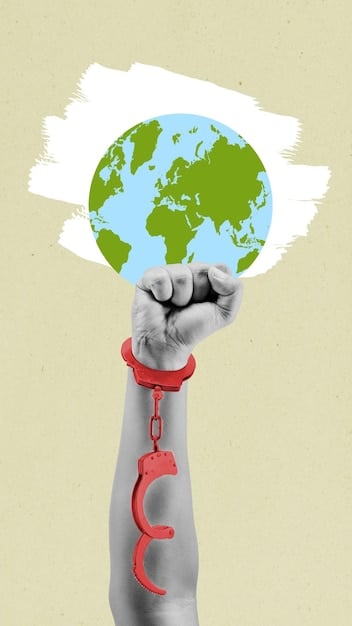Key Differences: Social Justice Movements Now vs. the 1960s

The key differences between current US social justice movements and those of the 1960s lie in their scope, technology use, intersectionality, and goals, with today’s movements addressing a broader range of issues and leveraging digital tools for mobilization and awareness.
The fight for social justice in the United States has a long and complex history. While the movements of the 1960s laid a crucial foundation, what are the key differences between current US social justice movements and those of the 1960s?
Social Justice Movements: A Shifting Landscape
Social justice movements have always been a part of the American story, evolving and adapting to the changing needs of society. Examining the differences between the movements of the 1960s and those of today provides valuable insights into the progress made, the challenges that remain, and the strategies employed to achieve a more just and equitable world.
Understanding these shifts helps to contextualize the current social and political climate and allows for a more informed engagement with the ongoing struggle for equality.
The Civil Rights Movement: A Foundation for Change
The Civil Rights Movement of the 1960s was a watershed moment in American history. Focused primarily on ending racial segregation and securing voting rights for African Americans, it employed tactics such as nonviolent protests, sit-ins, and marches to challenge discriminatory laws and practices.
Leaders like Martin Luther King Jr. and Rosa Parks became iconic figures, inspiring millions to join the fight for equality. This was a defining era, shaping the future of social justice advocacy in the US.
Key Focus Areas of the Civil Rights Movement
The Civil Rights Movement concentrated on issues affecting African Americans in the United States, primarily in the Jim Crow South.
- Desegregation: Overturning laws that mandated racial segregation in schools, public transportation, and other public facilities.
- Voting Rights: Ensuring that African Americans were able to exercise their right to vote without facing intimidation or discriminatory practices.
- Equal Opportunity: Fighting for equal access to employment, housing, and other opportunities.
While the Civil Rights Movement achieved significant legal victories, it also faced violent opposition and deep-seated resistance. The echoes of this struggle continue to resonate in contemporary social justice movements.

Broader Scope: Intersectionality and Inclusivity Today
Contemporary social justice movements address a broader range of issues than the movements of the 1960s. This expanded scope reflects a growing awareness of the interconnectedness of various forms of oppression and a commitment to intersectionality, which recognizes that individuals can experience multiple forms of discrimination based on factors such as race, gender, sexual orientation, and socioeconomic status.
In contrast to the more singular focus of the 1960s, today’s movements embrace a more holistic approach.
Intersectionality: The Core of Modern Movements
The concept of intersectionality, coined by Kimberlé Crenshaw, has become a central framework for understanding and addressing social injustice. This perspective emphasizes the ways in which different forms of discrimination intersect and compound one another.
- Gender and Racial Justice: Addressing the unique challenges faced by women of color, who experience both sexism and racism.
- LGBTQ+ Rights and Racial Justice: Recognizing the intersection of sexual orientation and racial identity, particularly for LGBTQ+ individuals of color.
- Disability Rights and Economic Justice: Advocating for the rights of people with disabilities, particularly those from low-income backgrounds.
This intersectional approach allows for a more nuanced and inclusive understanding of social injustice, leading to more effective and equitable solutions.
Technology as a Tool for Mobilization and Awareness
One of the most significant differences between current and past social justice movements is the pervasive use of technology. Social media platforms, online organizing tools, and digital communication channels have revolutionized the way activists mobilize, share information, and raise awareness.
While the movements of the 1960s relied on traditional media outlets and word-of-mouth, today’s movements can bypass traditional gatekeepers and reach a global audience instantly.
The Power of Social Media in Modern Activism
Social media has become an indispensable tool for social justice movements, enabling activists to connect with supporters, organize protests, and amplify their message.
- Rapid Dissemination of Information: Sharing news, personal stories, and educational resources quickly and widely.
- Building Online Communities: Creating virtual spaces for activists to connect, collaborate, and support one another.
- Challenging Mainstream Narratives: Providing alternative perspectives and counter-narratives to challenge dominant viewpoints.
However, the use of technology also presents challenges, such as the spread of misinformation, online harassment, and surveillance by law enforcement.
Shifting Goals and Strategies: From Legal Equality to Systemic Change
While the Civil Rights Movement focused primarily on achieving legal equality, contemporary social justice movements aim for more comprehensive systemic change. This includes addressing not only discriminatory laws and policies but also the underlying social, economic, and cultural structures that perpetuate inequality.
Today’s movements recognize that achieving true justice requires dismantling systems of power and privilege that benefit some at the expense of others.
Systemic Change: A Holistic Approach
Contemporary social justice movements seek to address the root causes of inequality by challenging systems of oppression and advocating for fundamental changes in society.
- Economic Justice: Addressing income inequality, poverty, and lack of access to resources and opportunities.
- Criminal Justice Reform: Challenging mass incarceration, police brutality, and racial bias in the criminal justice system.
- Environmental Justice: Recognizing the disproportionate impact of environmental degradation on marginalized communities.
This emphasis on systemic change requires a long-term commitment and a willingness to challenge deeply entrenched power structures.

Evolving Public Opinion and Political Landscape
Public opinion on social justice issues has shifted significantly since the 1960s. While progress has been made in areas such as racial equality and LGBTQ+ rights, deep divisions remain, and backlash against social justice movements is common.
The political landscape has also become increasingly polarized, making it more difficult to achieve consensus on issues of social justice.
Polarization and the Challenges Ahead
The rise of political polarization has created significant challenges for social justice movements, making it more difficult to build broad-based support and enact meaningful change.
- Erosion of Trust in Institutions: Declining public trust in government, media, and other institutions.
- Rise of Extremism: The growing influence of extremist groups and ideologies that oppose social justice.
- Challenges to Democratic Norms: Attempts to suppress voting rights and undermine democratic institutions.
Navigating this complex and challenging landscape requires strategic thinking, coalition building, and a commitment to nonviolent resistance.
Conclusion
While the social justice movements of the 1960s laid the groundwork for progress, today’s movements are characterized by a broader scope, greater use of technology, a focus on intersectionality, and a commitment to systemic change. These differences reflect a deeper understanding of the complexities of social injustice and a recognition that true equality requires dismantling systems of power and privilege. The road ahead remains challenging, but the commitment to building a more just and equitable world remains unwavering.
| Key Areas | Brief Description |
|---|---|
| 🎯 Focus | 1960s: Desegregation & voting rights; Today: Systemic change covering multiple issues. |
| 📱 Technology | 1960s: Traditional media; Today: Social media and online platforms for rapid reach. |
| 🤝 Intersectionality | 1960s: Singular focus on race; Today: Recognition of interconnected discriminations. |
| ⚖️ Goals | 1960s: Legal equality; Today: Systemic change. |
Frequently Asked Questions
▼
The primary objective was to end legal segregation and gain equal rights for African Americans, especially in the Jim Crow South. This included securing voting rights and equal access to public facilities.
▼
Technology, particularly social media, has enabled movements to mobilize rapidly, disseminate information widely, and build online communities. It allows for direct engagement and bypasses traditional media gatekeepers.
▼
Intersectionality recognizes that individuals can experience multiple forms of discrimination based on factors like race, gender, and class. Modern movements strive to address these intersecting oppressions for more holistic change.
▼
Systemic change involves addressing the root causes of inequality by challenging and dismantling oppressive social, economic, and political structures. It goes beyond legal equality to affect fundamental change.
▼
Although public opinion has evolved, social justice movements face polarization and backlash. Shifting political landscapes require strategic planning and broadening support to enable meaningful societal changes.
Conclusion
In conclusion, while both eras share a commitment to justice, the shifts in scope, technology, intersectionality, and goals highlight the continuous evolution of social justice movements. Understanding these nuances helps us navigate the ongoing quest for equality.





